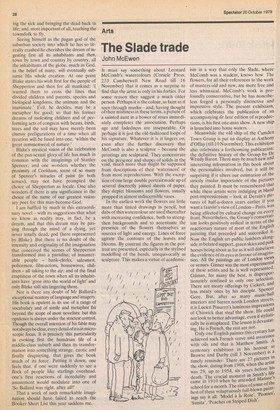The Slade trade
John McEwen
It must say something about Leonard McComb's watercolours (Coracle Press, 233 Camberwell New Road till 16 November) that it comes as a surprise to find that the artist is only in his forties. For some reason they suggest a much older person. Perhaps it is the colour, as faint as if seen through muslin — and, having thought of their mistiness in these terms, a picture of a sainted aunt in a bower of roses immediately completes the association. Perhaps age and fadedness are inseparable. Or perhaps it is just the old-fashioned loops of his signature. Whatever it is it lingers on, even after the further discovery that McComb is also a sculptor — because the paintings are sculptural. They concentrate on the presence and shapes of solids in the void, much more than might be supposed from descriptions of their 'wateriness' or from most reproductions. With the exception of one large double portrait made up of several discreetly joined .sheets of paper, they depict blossoms and flowers, usually propped in almost indiscernible vases.
In the earliest work the flowers are little more than tinted drawings in pencil, but dabs of thin watercolour are used thereafter with increasing confidence, both to strengthen backgrounds and to accentuate the presence of the flowers themselves as sources of light and energy. Lines of force agitate the contours of the leaves and blooms. By contrast the figures in the portrait are presented, especially in the stylised modelling of the heads, unequivocally as sculpture. This makes a virtue of academic ism in a way that only the Slade, where McComb was a student, knows how. The flowers, for all their references to the work of masters old and new, are more free and less whimsical. McComb's work is profoundly conservative, but he has nonethe less forged a personally distinctive and impressive style. The present exhibition, which celebrates the publication of an accompanying de luxe edition of reproductions, is his first one-man show. A new ship is launched into home waters.
Meanwhile the old ship of the Camden Town Group is put on display at Anthony d'Offay (till 10 November). This exhibition also celebrates a forthcoming publication: the definitive history of the Group by Dr Wendy Baron. There may be much new and interesting information in this book about the personalities involved, but it will be surprising if it alters our estimation of the strictly insular importance of the pictures they painted. It must be remembered that while these artists were indulging in bland post-impressionism — look at Derain's pictures of half-a-dozen years earlier if you want a fauvist's view of London — Paris, was being affected by cultural change on every front. Nevertheless, the Group's conservat ism looks positively radical in terms of the reactionary nature of most of the English painting that preceded and succeeded it. Now the English art-public lumbers alongside in belated support, green skies and pink horses being about as far as it will disbelieve the evidence of its eyes in favour of imagination.•All the paintings are Of London views or venues. Ginner was the most experimental of these artists and he is well represented. Gilman, for many the best, is disproportionately confined to only one selection. There are meaty offerings by Cickert, and less meaty ones by his disciple. Spencer Gore. But, after so many music-hall interiors and barren north London streets, it is Lucien Pissarro's luminous impressions of Chiswick that steal the show. He could not look to better advantage, even if stylistically he is misplaced. The lesson is devastat ing. He is French, the rest are not. Only one English painter this century has achieved such French verve and assuranci, with oils and that is Matthew ,Smith. A centenary exhibition in his honour. at Browse and Darby (till 3 November) is,a timely reminder. There are 27 pictures in the show, dating from 1908, when the artist was 29, up to 1954, six years before his death. The crucial moment in Smith Ii came in 1910 when he attended Matisse s school for a month. The titles of some of the best of these voluptuously full-blown paint ings say it all: 'Model a la Rose', 'Peonies, `Sunita', Teaches on Striped Dish'.






































 Previous page
Previous page